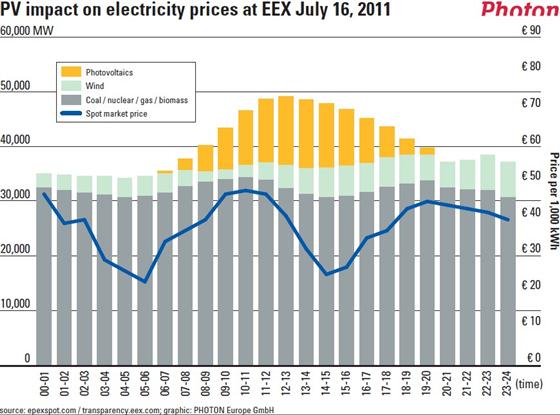Photovoltaics cause prices to drop on the European Electricity Exchange
On July 16, the price of electricity on the EEX dropped to off-peak night levels in the middle of the day

Aachen, July 22, 2011: Saturday, July 16, 2011, is a date that will be remembered in the history of the German electricity sector. On that Saturday afternoon, electricity prices on the spot market of the European Electricity Exchange collapsed to the low level of electricity rates that are available at night. Buyers paid only 2.5 euro cents per kilowatt-hour for electricity delivered between 2 and 3 pm. Electricity rates are usually twice as high as the (low) night rate at this time of day on weekends in Germany. PHOTON had already predicted this decline, which resulted from strong growth in German photovoltaic installations, as early as 2008.
Anyone following the development of electricity prices on the European Electricity Exchange (EEX) on July 16 would have observed the following: whenever less than 31 gigawatts (GW) of conventional power plant capacity was needed, the price of electricity fell. The lowest rates were reached between 5 and 6 am, at 2.3 euro cents per kilowatt-hour (kWh), and also from 2 to 3 pm at 2.5 euro cents - about half of the maximum daily price. At night, low prices are the result of reduced demand; but the low values observed on the afternoon of July 16 were caused by the contribution of Germany's photovoltaic (PV) installations. It was obviously possible to meet demand during those periods with electricity from base-load power stations, running at operating costs ranging from 2 to 3 euro cents, as well as with 12 GW of solar energy and 6 GW of wind power (each of which has no operating costs).
Benefits for consumers and industry
As the summer progresses, PV is expected to push down exchange prices to levels of nighttime electricity for longer and longer periods during the day in Germany. Residential ratepayers will benefit from this development, but only after some delay. Because municipal utilities typically buy one-twelfth of their power needs in advance, it may take up to 3 years for lower electricity prices on the EEX to unfold its full effect in German consumer's utility bills. For consumers it will be interesting to see when utilities offer variable rates based on actual electricity prices at the exchange throughout the day. Unlike in the past, nighttime rates will be available not only at night but during midday as well, while high peak rates will apply only in the early morning and evening.
Large commercial electricity consumers already have the opportunity to profit from this development. They often buy electricity directly or through distributors on the market; they can thus adjust their purchasing behavior in the short term. »These developments belie the predictions of drastically rising electricity prices due to the German Renewable Energy Law (EEG) for this customer segment,« says Philippe Welter, publisher of PHOTON - a publishing group whose magazines cover the solar industry and are available in Chinese, English, German, French, Italian and Spanish.
Falling profits in the conventional energy economy
If expensive peak-load power stations are no longer required during midday, this leads to massive profit slumps for conventional power plant operators. According to the rules of the EEX, power plant operators are not paid the price based on their original offer; instead, those selected receive the level of the offer from the highest bid. Thus Germany's four major power plant operators, EnBW, EoN, RWE and Vattenfall, have all been able to realize high profits over the years by selling cheap base-load electricity for high rates during the middle of the day - traditionally the period of the highest demand. »In the future, growth in PV installations will prevent conventional plant operators from reaping excessive profits from consumers on the exchange at midday between April and September,« says Welter.
July 16 demonstrates the flaws in German Environment Minister Röttgen's »market premium« concept
PV in Germany is rapidly expanding under the EEG, which guarantees fixed feed-in tariffs for 20 years. In the new version of the law, Germany's Environment Minister Norbert Röttgen has added a so-called optional market premium as part of the incentives to operators of renewable energy systems. The reasoning was that this premium will help renewables become more market-oriented. »Röttgen ignores the fact that in the long run, it is simply not possible to achieve a higher price on the energy exchange than the variable costs of the last remaining conventional power plants,« says Welter. A »premium« that is supposed to encourage operators of wind power plants and PV systems to waive the established cost-oriented feed-in tariffs in exchange for the potential benefit of greater incentives due to higher market prices in the future is therefore necessarily ineffective. As of July 16, 2011, operators can at least agree that low prices will prevail when large amounts of solar- and
wind-generated electricity are available on the EEX.
